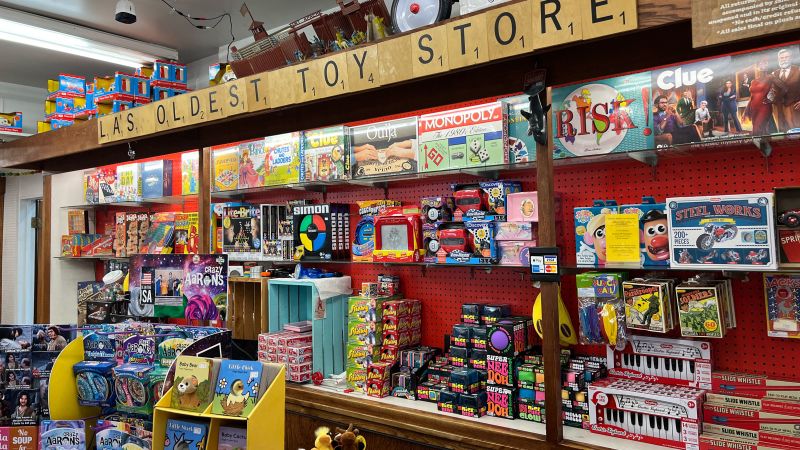The iconic Kip’s Toyland, a cherished establishment in Los Angeles, has spent nearly eight decades delighting children with its vast array of toys. Yet, as the world confronts significant geopolitical tensions, the oldest toy store in the city now finds itself in a precarious position. The introduction of exorbitant tariffs, specifically a staggering 145% on most imports from China, poses a dire threat to the livelihoods of small business owners like Don Kipper, the current proprietor of Kip’s Toyland. Alarmingly, this scenario occurs at a time when approximately 80% of toys available in the American market originate from China.
In a candid conversation with CNN, Kipper relayed alarming messages he received from suppliers, who cautioned him to prepare for soaring costs. “We’ve been getting letters and other communication from our suppliers that say, ‘Fasten your seat belts, this is on the way,’” he shared, underlining the blunt reality shaping his business landscape. As these suppliers communicated impending price hikes, they also encouraged Kipper to make bulk orders before the tariffs officially took effect, a move that posed practical challenges for a small business already struggling against the odds.
Kip’s Toyland, an enterprise that has seen its fair share of economic tumult, is yet another casualty of President Donald Trump’s controversial trade war compounded by China’s retaliatory tariffs. The American toy industry is experiencing adverse effects, highlighted by the staggering figure of $13.4 billion worth of toy imports from China in the previous year alone, according to data from the US Commerce Department. This trade scenario underscores the robust toy manufacturing infrastructure established in China over the past 25 years, a factor that has not only supported import but also rendered American toy manufacturing obsolete for many brands.
For Kipper, the situation is particularly challenging. With his inventory predominantly sourced from China, the imposition of tariffs translates directly into increased prices, putting the store’s operational viability at risk. Given the limited capacity of small businesses to stock quantities or house extensive inventories, Kipper finds himself grappling with uncertainty about how his toy store will adapt to these mounting costs.
In addition to warnings about price adjustments, Kipper received distressing news about halting production lines from some of his suppliers. These disruptions threaten to limit the availability of toys in several key sales periods, including holiday seasons when consumer demand typically peaks. “Please know this decision was not made lightly,” he recounted from one of the letters he read aloud, sharing a glimpse into the collective dread embedded within this intricate supply chain.
The toy store’s historical roots add an emotional layer to this current crisis. Founded by Irvin “Kip” Kipper—Don’s father—Kip’s Toyland emerged from the ashes of World War II. After enduring a harrowing experience as a prisoner of war, Kip Kipper resolved to embrace positivity, leading to the store’s establishment in 1945. Elliott Kipper’s entrepreneurial spirit replaced a desolate war-torn past with the vibrancy of a thriving toy store, revolutionizing the market by focusing solely on toys at a time when such stores were virtually non-existent.
Kip’s Toyland serves as a nostalgic sanctuary for timeless toys even as the landscape of manufacturing has shifted dramatically towards China. Don Kipper emphasizes the relative rarity of American-made toys today, with many once-beloved brands now either out of business or absorbed by larger corporations. Independent toy analyst Chris Byrne explains that while the infrastructure for toy manufacturing in the U.S. could theoretically be resurrected, such transitions would require extensive timelines and come with increased production costs.
Despite the evolving dynamics, Kip’s Toyland retains its charm, offering a selection of classic toys that eschew modern technology. This allure is particularly evident to patrons like Aeri Schwartz, who cherish the unique in-person shopping experience. However, the looming price hikes might lead families to reconsider their purchasing habits. As Schwartz articulates, the sentimental value of shopping for toys in such a haven could soon clash with financial practicality, prompting many to explore alternative options such as memberships to local attractions or second-hand purchases.
As Kip’s Toyland navigates these economic hurdles, Don Kipper remains hopeful about maintaining connections with loyal customers. Yet, he is acutely aware that shifting purchasing norms could impact store operations, reflecting the broader challenges facing small businesses amid geopolitical turmoil. The fate of such establishments rests on consumers’ willingness to continue supporting local traditions in the face of daunting economic pressures. Kipper’s concise reflection underscores this uncertainty: “It’s a hostage situation. If we have to, we have to.” The future of Kip’s Toyland and similar establishments hangs in the balance as they respond to the rapidly evolving market landscape.



